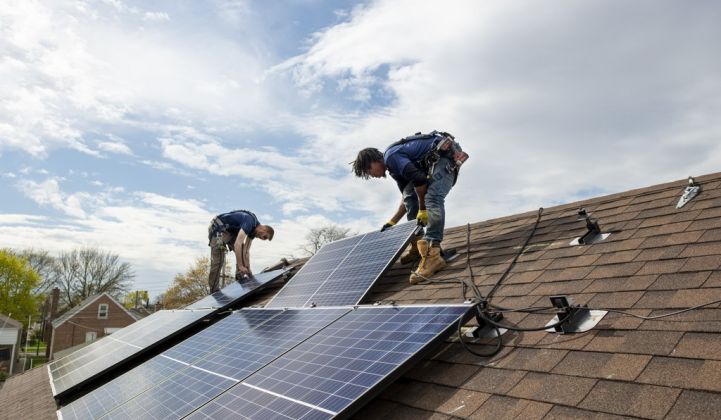Leading U.S. rooftop solar installer Sunrun has bounced back from the slump it experienced at the height of coronavirus shutdowns.
The company installed 109.5 megawatts in the third quarter, up 40 percent from 78.1 MW in the second quarter. That installed capacity also marked a 2 percent increase over Q3 of 2019.
That means Sunrun is back in growth territory after the coronavirus crisis put a pause on in-person sales and some installation work earlier this year. But the company has more work to do to get back to its pre-pandemic trajectory.
Company leadership predicted Thursday that deployments would rise 10 percent in the fourth quarter of this year to 121.5 MW, which would beat its previous record of 117 MW in Q4 2019. But that would still see the company fall short of the 11 percent annual growth in deployment it achieved in 2019.
Sunrun had more progress to report in its energy storage business, which the company describes as a value-add for solar customers and a differentiator from other solar offerings. The San Francisco-based company has now installed 13,000 BrightBox solar-charged battery systems, up from the previously reported 10,000 in May, and is making the product available to all states where it sells solar.
The merger between Sunrun and Vivint Solar, the second-largest rooftop solar installer, closed in October, so the companies did not report combined financials for the third quarter. The combined companies will grow above the market average in 2021 and will do so while managing margins, Sunrun CEO Lynn Jurich said on a Thursday call with investors.
Growth in storage, but revenue remains distant
Sunrun also expanded its virtual power plant efforts with utility Southern California Edison, signing a 5 MW grid services contract which will pay a fixed rate over 10 years for Sunrun to aggregate batteries in that territory. That contract will kick in in 2023.
The newly announced deal followed a partnership made public in June, involving 300 existing Sunrun solar customers in SCE territory. Evidently, SCE decided it didn't need to wait for the full year of testing to move ahead with a more formal agreement.
"This is a very long contract...with a very sophisticated, large utility," Jurich said in an interview Thursday. The 5 MW deal with SCE builds on a number of solar-storage aggregations that Sunrun is working on in California, Massachusetts, New York and Hawaii. Virtual power plant contracts are an emerging grid product, however, and some formats only lock in a few years' worth of predictable revenue.
BrightBox sales are up 45 percent compared to Q3 2019, Jurich said, and 2021 installations are expected to double from 2020, expanding the range of customers that could be enlisted to help utilities mitigate peak grid demands.
Still, it will be a few years before grid services contribute significant revenue to quarterly earnings, Jurich noted. Partly that's because it takes a few years for the company's contracts to kick in. It also takes time to install enough equipment in people's homes to generate appreciable grid services revenue.
That's an area where the combined forces of Sunrun and Vivint have an edge, she said. "We have these grid services programs, and it’s hard for other players to compete for those because they don’t have the scale or the visibility we built over the last decade."
One of those competitors that trailed Sunrun on battery sales was Vivint. But the former Vivint crews have now increased their battery attachment rate in California to 20 percent, Jurich said.
Lower costs from COVID-driven virtual sales yet to emerge
As quarantine set in back in March, the solar industry lost its favorite sales technique: the face-to-face chat in a potential customer's house.
But as more tech-savvy installers migrated their sales tactics online, they noticed a new opportunity: Selling in quarantine could force improvements that would ultimately lower customer-acquisition costs, a persistent challenge for rooftop solar companies. Sunrun previously said it could save $2,000 per installation based on this digital-first approach.
"It was a real accelerator; it did increase our corporate metabolism," Jurich said of the shift to virtual sales. But "it takes time for it all to wash through" in terms of lowering customer-acquisition costs.
Sunrun's "creation cost," or the cost of adding a new solar customer, stood at $3.55 per watt in Q3. That's down from the previous quarter's $3.72 per watt, but well above the annual figure for any of the last three years.
The more expensive creation cost is largely due to an increase in the cost of installation since Q1, likely stemming from the logistical complexities of working during a pandemic. Sales and marketing expenses peaked in Q2 and in Q3 fell back to the level they were at in 2019.
"While Sunrun showed quarter-over-quarter declines in creation costs, these remain much higher overall for Q3 than they were at the start of the year," said Bryan White, solar analyst at Wood Mackenzie. "Sales and marketing costs also dipped from historic highs in Q2, but we have yet to fully see the $2,000 per customer cost reductions due to changes in operations brought on by COVID-19 that Sunrun has cited.”



